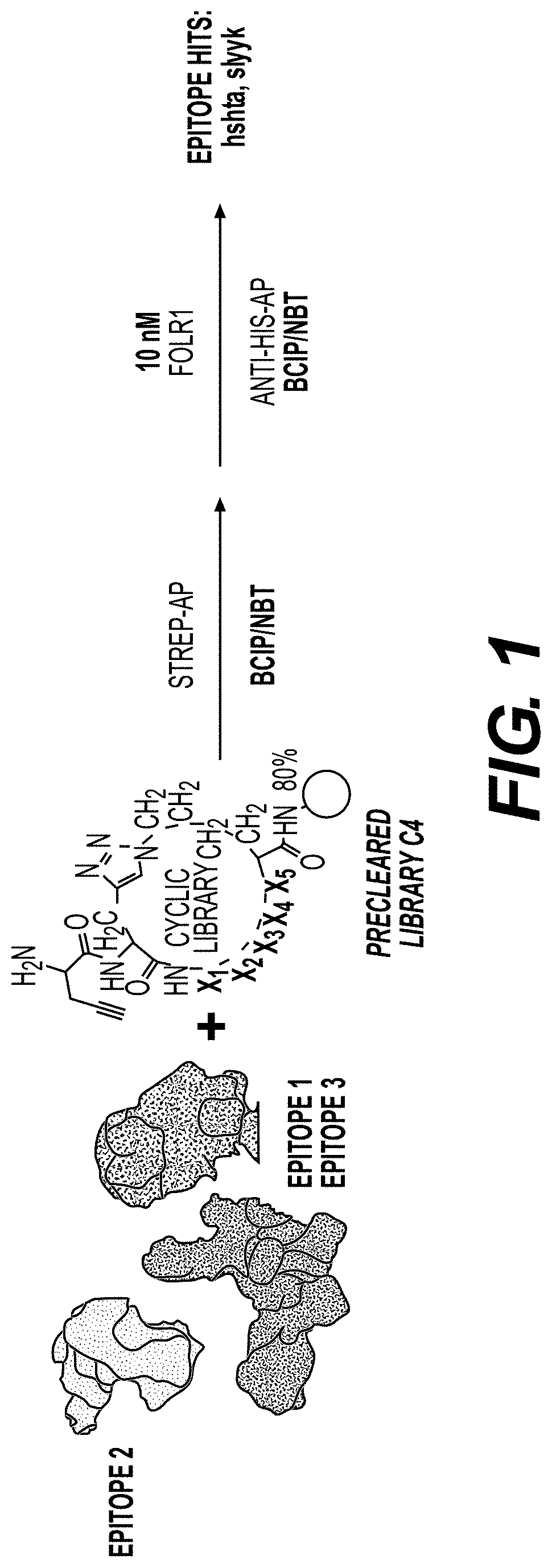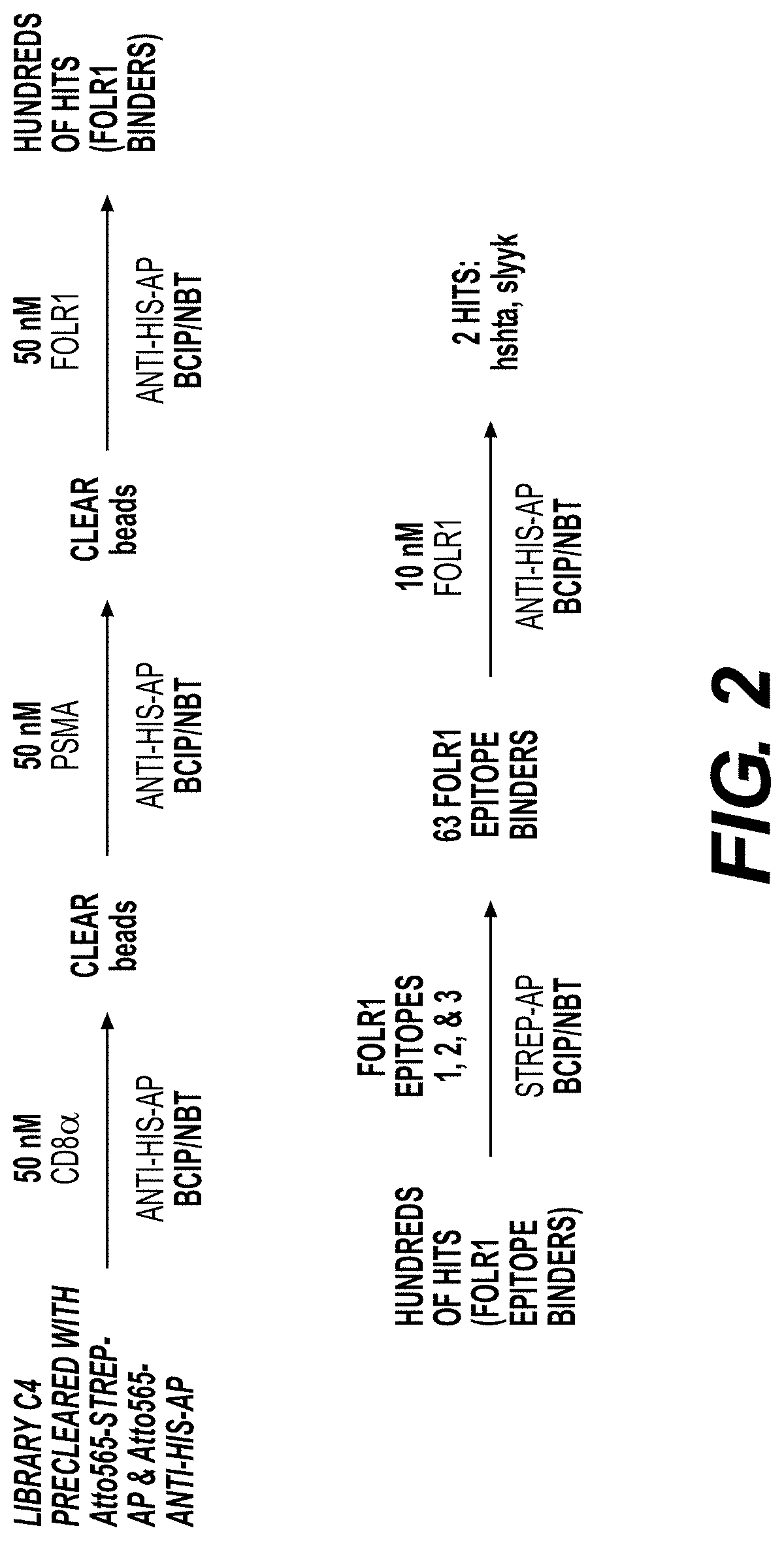Compositions, delivery systems, and methods useful in tumor therapy
a delivery system and tumor technology, applied in the field of tumor therapy, can solve the problems of toxic first component, toxic first component to the kidney, lung or heart,
- Summary
- Abstract
- Description
- Claims
- Application Information
AI Technical Summary
Benefits of technology
Problems solved by technology
Method used
Image
Examples
example 1
of Heterobiligands Having Different Combinations of Components
Materials and Methods
[0370]Library Synthesis
[0371]Screens were performed using a triazole-cyclized OBOC library of the form H2N-Pra-(Pra-X1X2X3X4X5-Az4)-Met-TG, where TG=TentaGel® S NH2 resin (S 30 902, Rapp Polymere), X1=one of sixteen D-amino acids (D-Ala, D-Arg, D-Asn, D-Asp, D-Glu, Gly, D-His, D-Leu, D-Lys, D-Phe, D-Pro, D-Ser, D-Thr, D-Trp, D-Tyr, D-Val), Pra=L-propargylglycine, and ( )=triazole cyclization via flanking Pra and Az4 (=L-azidolysine) residues. An encoded cyclic peptide library (ECPL) was created where 20% of the peptide on each bead is a linear tag for MALDI-TOF / TOF sequencing, while 80% remains the cyclic peptide for ligand discovery. The OBOC library was synthesized using Fmoc-based solid-phase synthesis on a Titan 357 automated peptide synthesizer (AAPPTEC). When synthesizing the ECPL, methionine was first coupled to the TentaGel beads as a cyanogen bromide (CNBr)-selective cleavage handle. Then, Az...
example 2
tudies of Heterobiligand Compounds
[0510]In order to establish a maximum tolerated dose (MTD), a tolerability study was undertaken testing increasing amounts of the 177-Lu heterobiligand 7327 (folate-hshta-Gly-Phe-Lys(DOTA)). Animals were monitored for signs of toxicity and weighed twice weekly. Repeated doses of 14.8 MBq, 22.2 MBq, 29.6 MBq, and 37 MBq were well tolerated (FIGS. 34 and 35). The second and third doses were administered 21 days following the previous dose. Doses of 111 MBq and 185 MBq were not tolerated (FIG. 35). At these high doses, animals lost substantial body weight following the first dose, which worsened following the second and third doses. This experiment established an MTD for 177-Lu 7327 of between 37 and 111 MBq. The tolerance of the 0 MBq arm suggests that the radionuclide drives the toxicity profile and not the peptide alone.
[0511]Female NSG mice were implanted subcutaneously with OVCAR3 cells. Once tumors reached volumes of 200 mm3, the animals were tre...
example 3
of Heterobiligands for Therapeutic Use Introduction
[0518]Folate receptor is highly overexpressed in ovarian cancer and presents an attractive target to specifically deliver therapeutic radiation. Indi 177Lu-7327 is a low molecular weight (˜2100 Da), water soluble, ultra-high affinity synthetic peptide-folate conjugate targeting the folate receptor alpha (FOLR). This construct is internalized into ovarian cancer cells by the cell's folate receptor, outcompeting native folate for receptor binding by approximately 500-fold. FOLR-targeted drugs can present significant renal toxicity unless rapidly cleared. Since FOLR is highly expressed in the kidney, the kidney exposure of Indi 177Lu-7327 is mitigated by inclusion of a 3-amino acid linker that is enzymatically cleaved at the renal brush border membrane. Upon cleavage, the intact 177Lu-DOTA fragment is released from the primary drug conjugate and passed to the bladder for excretion. The drug is highly stable in human plasma and due to t...
PUM
| Property | Measurement | Unit |
|---|---|---|
| Length | aaaaa | aaaaa |
| Length | aaaaa | aaaaa |
| Electric charge | aaaaa | aaaaa |
Abstract
Description
Claims
Application Information
 Login to View More
Login to View More - Generate Ideas
- Intellectual Property
- Life Sciences
- Materials
- Tech Scout
- Unparalleled Data Quality
- Higher Quality Content
- 60% Fewer Hallucinations
Browse by: Latest US Patents, China's latest patents, Technical Efficacy Thesaurus, Application Domain, Technology Topic, Popular Technical Reports.
© 2025 PatSnap. All rights reserved.Legal|Privacy policy|Modern Slavery Act Transparency Statement|Sitemap|About US| Contact US: help@patsnap.com



